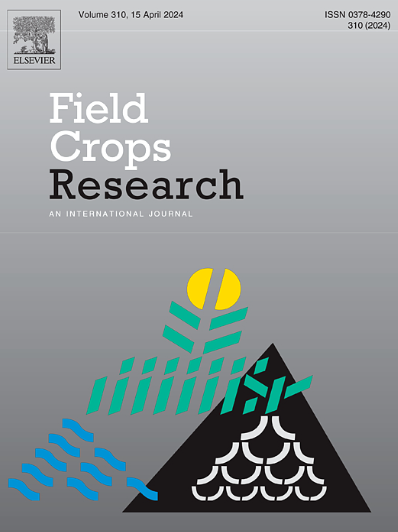Revisiting plant density by environment interaction in maize across contrasting sowing dates
IF 5.6
1区 农林科学
Q1 AGRONOMY
引用次数: 0
Abstract
Context
The definition of the agronomic optimum plant density (AOPD) in maize is a critical management practice due to seed cost and impact on final yield. Farmers often reduce plant density when planting later in the season because of the lower expected yield compared to earlier plantings. However, this practice may lead to lost yield opportunities that need to be quantified.
Objectives
Our objectives were i) to understand how farmers define maize plant density for different planting dates and, ii) to explore the yield response to plant density in early and late plantings across a range of yield environments (YE).
Methods
We explored maize on-farm records (2017–2021; n = 25,143 fields) and field experiments (n = 491 paired comparisons) across Argentina under early (ESM) and late (LSM) plantings to characterize plant density used by farmers and attainable yields at contrasting sowing dates. Then, we conducted field experiments across different YEs, where several commercial genotypes were tested at different plant densities under both ESM (n = 39 location-years) and LSM (n = 54 location-years).
Results and conclusion
The proportion of area with ESM and LSM varied across regions and YEs in Argentina. Farmers usually chose higher plant densities at ESM than LSM, but not necessarily ESM always out-yielded LSM in the study region. Maize response to plant density varied depending on the YE, with no apparent difference between sowing dates.
Implications
Although practical reasons often justify reducing plant density in later planting, farmers should base their decisions about the AOPD based on the expected YE regardless of the planting date. Accurately predicting the YE should therefore be a key priority to optimize yields and resource allocation. The expected yield in later planting seems to be currently underestimated by farmers.
不同播期玉米植株密度的环境互作研究
背景由于种子成本和对最终产量的影响,确定玉米的农艺最佳植株密度(AOPD)是一项至关重要的管理措施。与早播相比,晚播的预期产量较低,因此农民通常会降低种植密度。我们的目标是:i)了解农民如何确定不同播种期的玉米种植密度;ii)探索在一系列产量环境(YE)下,早播和晚播种植密度对产量的影响。方法我们研究了阿根廷早播(ESM)和晚播(LSM)玉米的农场记录(2017-2021 年;n = 25,143 块田地)和田间试验(n = 491 项配对比较),以确定农民在不同播种期使用的植株密度和可达到的产量。然后,我们在不同的YE进行了田间试验,在ESM(n = 39个地点-年)和LSM(n = 54个地点-年)条件下,以不同的种植密度对几种商业基因型进行了测试。在研究地区,农民通常会选择ESM比LSM更高的植株密度,但不一定ESM总是比LSM产量高。虽然出于实际原因,晚播时降低植株密度往往是合理的,但无论播种日期如何,农民都应根据预期的YE来决定AOPD。因此,准确预测 YE 应成为优化产量和资源分配的关键优先事项。目前,农民似乎低估了晚播的预期产量。
本文章由计算机程序翻译,如有差异,请以英文原文为准。
求助全文
约1分钟内获得全文
求助全文
来源期刊

Field Crops Research
农林科学-农艺学
CiteScore
9.60
自引率
12.10%
发文量
307
审稿时长
46 days
期刊介绍:
Field Crops Research is an international journal publishing scientific articles on:
√ experimental and modelling research at field, farm and landscape levels
on temperate and tropical crops and cropping systems,
with a focus on crop ecology and physiology, agronomy, and plant genetics and breeding.
 求助内容:
求助内容: 应助结果提醒方式:
应助结果提醒方式:


